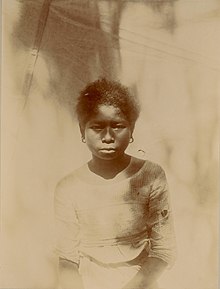Our website is made possible by displaying online advertisements to our visitors.
Please consider supporting us by disabling your ad blocker.
Aeta people
| |
|---|---|
 | |
| Total population | |
| 50,236[1] | |
| Regions with significant populations | |
| Languages | |
| Philippine Negrito languages, Kapampangan, Ilocano, Filipino, English | |
| Religion | |
| Christianity, Anito, folk religions | |
| Related ethnic groups | |
| Batak, Manobo, Mamanwa; other Negrito peoples |
Aeta (Ayta /ˈaɪtə/ EYE-tə), Agta and Dumagat, are collective terms for several indigenous peoples who live in various parts of Luzon islands in the Philippines. They are included in the wider Negrito grouping of the Philippines and the rest of Southeast Asia, with whom they share superficial common physical characteristics such as: dark skin tones; short statures; frizzy to curly hair; and a higher frequency of naturally lighter hair colour (blondism) relative to the general population. They are thought to be among the earliest inhabitants of the Philippines—preceding the Austronesian migrations.[2][3] Regardless, the modern Aeta populations have significant Austronesian admixture, and speak Austronesian languages.[4]
Aeta communities were historically nomadic hunter-gatherers, typically consisting of approximately one to five families per mobile group.[5] Groups under the "Aeta" umbrella term are normally referred to after their geographic locations or their common languages.[6][7][8][9]
- ^ Cite error: The named reference
popwas invoked but never defined (see the help page). - ^ "The Aeta". peoplesoftheworld.org. Archived from the original on February 26, 2012. Retrieved June 16, 2012.
- ^ Larena, Maximilian; McKenna, James; Sanchez-Quinto, Federico (2021). "Philippine Ayta possess the highest level of Denisovan ancestry in the world". Current Biology. 31 (19): 4219–4230. doi:10.1016/j.cub.2021.07.022. PMC 8596304. PMID 34388371.
- ^ Cite error: The named reference
Reid2was invoked but never defined (see the help page). - ^ Allingham, R. Rand (December 2008). "Assessment of Visual Status of the Aeta, a Hunter-Gatherer Population of the Philippines (An AOS Thesis)". Transactions of the American Ophthalmological Society. 106: 240–251. ISSN 0065-9533. PMC 2646443. PMID 19277240.
- ^ Cite error: The named reference
Reidwas invoked but never defined (see the help page). - ^ Balilla, Vincent S.; Anwar McHenry, Julia; McHenry, Mark P.; Parkinson, Riva Marris; Banal, Danilo T. (2013). "Indigenous Aeta Magbukún Self-Identity, Sociopolitical Structures, and Self-Determination at the Local Level in the Philippines". Journal of Anthropology. 2013: 1–6. doi:10.1155/2013/391878. ISSN 2090-4045.
- ^ Rai, Navin K (1989). From forest to field: a study of Philippine Negrito foragers in transition (Thesis). Ann Arbor, Mich.: University Microfilms. OCLC 416933818.
- ^ Griffin, P. Bion (2001). "A Small Exhibit on the Agta and Their Future". American Anthropologist. 103 (2): 515–518. doi:10.1525/aa.2001.103.2.515. ISSN 1548-1433.
Previous Page Next Page


